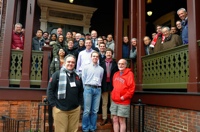19th International Conference on Microlensing
12, 2-hour sessions over three days
Suggested session topics:
- Microlensing with Big data
- New discoveries in microlensing
- Lens modeling
- What is the state-of-the-art now
- What are the challenges ahead
- How can we approach those problems
- Mini primer dedicated to modeling
- Computational aspects, challenges and opportunities
- Crowded Field photometry
- State-of-the art
- New approaches
- Computational aspects, challenges and opportunities
- Data challenges - microlensing for the unwashed masses
- Higher order microlensing effects
- Theoretical considerations
- How to model these effects
- State-of-the-art in modeling
- Observatory modeling
- Observatory systematics
- Vis-a-vis higher order effects
- Vis-a-vis more complex lens geometries
- Other Galactic bulge science
- Bulge modeling
- Milky Way central black hole research
- Globular clusters
- Planetary system formation history
- Calibration of models using microlensing planets
- Statistical
- Other collateral/ancillary science
- What could be derived directly from ground and space-based microlensing data sets - as is
- What other observations or changes to the current schema could improve ancillary science output
- Space-borne ulensing missions
- WFIRST
- SAG 11 Report
- Euclid
- A description of the Euclid microlensing survey
- Status update
- Microlensing capabilities
- Parallax capabilities when used with ground and WFIRST observatories
- Ground-based microlensing in the era of WFIRST and Euclid
- What ground observatories could do during these missions
- Optimization of ground campaigns for increased science gain
- Precursor ground observations
- Unbound planets
- Finding masses
- Calibration of FF population mass estimates in the absence of simultaneous parallax for most detections
- Black holes, white dwarfs and other non-exoplanet lenses
Important Info
Date: January 19-22, 2015
Opening Reception: January 18, 2015
Excursion: January 22, 2015
Location: Annapolis, MD



